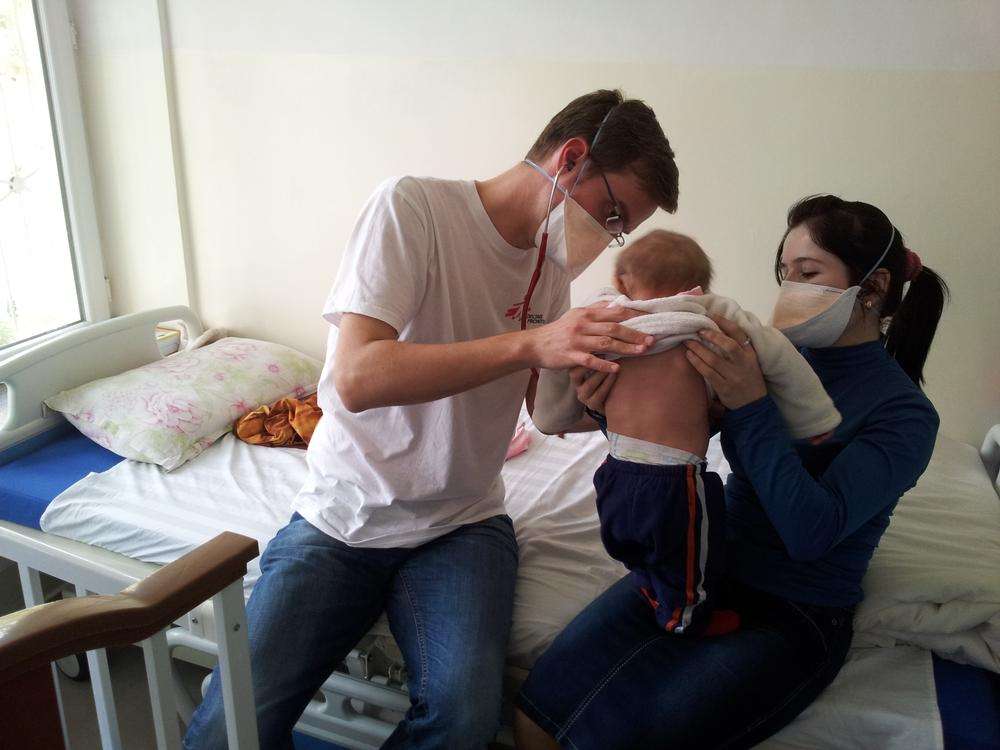Few children at the pediatric tuberculosis hospital in Dushanbe look as active and healthy as nine-month-old Shirinmo. The little girl is bright and busy as she crawls across the waiting room floor. But get closer and you can hear that her breath comes in gasps and has a rattling sound. The devastating diagnosis: she is suffering from multidrug-resistant tuberculosis (MDR-TB), a disease that spreads easily and, if left untreated, kills.
“Shirinmo is not the youngest child we have seen with tuberculosis, but she is the youngest patient we have diagnosed with MDR-TB,” says Dr. Christoph Hoehn of Doctors Without Borders/Médecins Sans Frontières (MSF), which opened its children’s MDR-TB project in Tajikistan in late 2011. “Babies have a high risk of developing these diseases because their immune system hasn’t fully matured,” he says.
Shirinmo’s diagnosis is the latest in a series of firsts for the MSF team. The baby was diagnosed using two new rapid detection methods introduced at the hospital in February 2013. With sputum induction, patients inhale a saline solution which loosens the sputum in their lungs. The sputum is then easily suctioned out. The method is safe to use on babies as young as one month old. Their sputum is then screened with GeneXpert, a new test for TB drug-resistance, which has cut the diagnosis time from 42 days to just two hours.
MSF has also started formulating MDR-TB drugs specifically for children at a pharmacy in Dushanbe. Until now, there were no MDR-TB formulations on the market for children, who had to take drugs produced for adults—usually large, hard-to-swallow pills with a very unpleasant taste. MSF staff have created a child-friendly syrup by dissolving the drugs in a flavored liquid, which is measured into appropriate doses for babies and adolescents. Tajikistan is the first MSF project where this formulation is being used to treat young patients, including Shirinmo.
In order to beat the disease, the little girl faces a huge challenge: for the next 18 months, she will have to swallow the syrup along with two other oral drugs, and for six of those months, she will also have injections of another drug. The treatment is so long and unpleasant that most adults have great trouble sticking to it. Fortunately, Dr. Hoehn says that children often have an easier time. “Children suffer less from the common side effects, which are nausea, vomiting, and joint pain,” he says.
One side effect of the injectable drugs is hearing problems, which affect up to half of all patients, and cause permanent deafness for some. The effect on children is not known. “We have no way to monitor the hearing of patients this young,” says Dr. Hohn.
There is a real lack of information and guidance on treating children with drug-resistant strains of TB. “Children with TB have been neglected for too long, especially children with MDR-TB,” says Grania Brigden, TB advisor for MSF’s Access Campaign. “We need to ensure that any new developments in TB treatment and diagnostics are made quickly available to children, and it is vital that new drugs for MDR-TB have formulations suitable for children.”
Children with TB who are diagnosed quickly and put on appropriate treatment—and who stick to it—have a good chance of being cured. As for Shirinmo, Dr. Hoehn says, “Overall, I think her chances are good if her mother can keep her on treatment. Fortunately she is very well nourished, which can often be a problem.” If all goes well, in 18 months the team in Dushanbe will be celebrating another first: MSF’s youngest MDR-TB patient successfully cured.
MSF currently has 30 children and adolescents on treatment for MDR-TB at its project in Tajikistan.
Patient's name has been changed.





